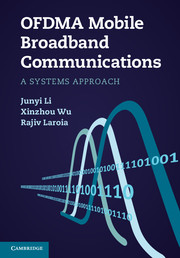Book contents
- Frontmatter
- Dedication
- Contents
- Foreword
- Preface
- List of Notation
- List of Abbreviations
- 1 Introduction
- 2 Elements of OFDMA
- 3 System design principles
- 4 Mitigation and exploitation of multipath fading
- 5 Intra-cell user multiplexing
- 6 Inter-cell interference management
- 7 Use of multiple antennas
- 8 Scheduling
- 9 Handoff in IP-based network architecture
- 10 Beyond conventional cellular frameworks
- A Overview of system operations
- B OFDM point-to-point communications
- C Brief review of channel capacity
- References
- Index
5 - Intra-cell user multiplexing
Published online by Cambridge University Press: 05 July 2013
- Frontmatter
- Dedication
- Contents
- Foreword
- Preface
- List of Notation
- List of Abbreviations
- 1 Introduction
- 2 Elements of OFDMA
- 3 System design principles
- 4 Mitigation and exploitation of multipath fading
- 5 Intra-cell user multiplexing
- 6 Inter-cell interference management
- 7 Use of multiple antennas
- 8 Scheduling
- 9 Handoff in IP-based network architecture
- 10 Beyond conventional cellular frameworks
- A Overview of system operations
- B OFDM point-to-point communications
- C Brief review of channel capacity
- References
- Index
Summary
In a cellular system where a base station communicates with multiple users in every cell, a key question is how to share the system resources (power and bandwidth) among cells and users. We will study two aspects related to this question. The first aspect is about how to create a large data pipe between the base stations and users. We focus on the intra-cell issues in this chapter and leave the study of the inter-cell issues in Chapter 6. Specifically, in this chapter we will investigate how different user multiplexing schemes affect data rates and what the Pareto-optimal user multiplexing schemes, are. For simplicity, we decouple user multiplexing and channel fading by assuming that the wireless channel gain does not vary over time or frequency. Communications over the wireless fading channel has been studied in Chapter 4. The second aspect is about how to share the data pipe among users in a fair manner taking into upper layer considerations such as quality of service, and will be studied in Chapter 8.
We compare different multiplexing schemes, including orthogonal and nonorthogonal ones, in terms of rate region. In orthogonal multiplexing, different users are allocated system resources non-overlapping in time and frequency. Time division multiplexing (TDM) and frequency division multiplexing (FDM, such as OFDMA) are two examples. As noted in Chapter 3, an important advantage of OFDMA lies in its orthogonality and flexibility in user multiplexing.
- Type
- Chapter
- Information
- OFDMA Mobile Broadband CommunicationsA Systems Approach, pp. 150 - 195Publisher: Cambridge University PressPrint publication year: 2013



